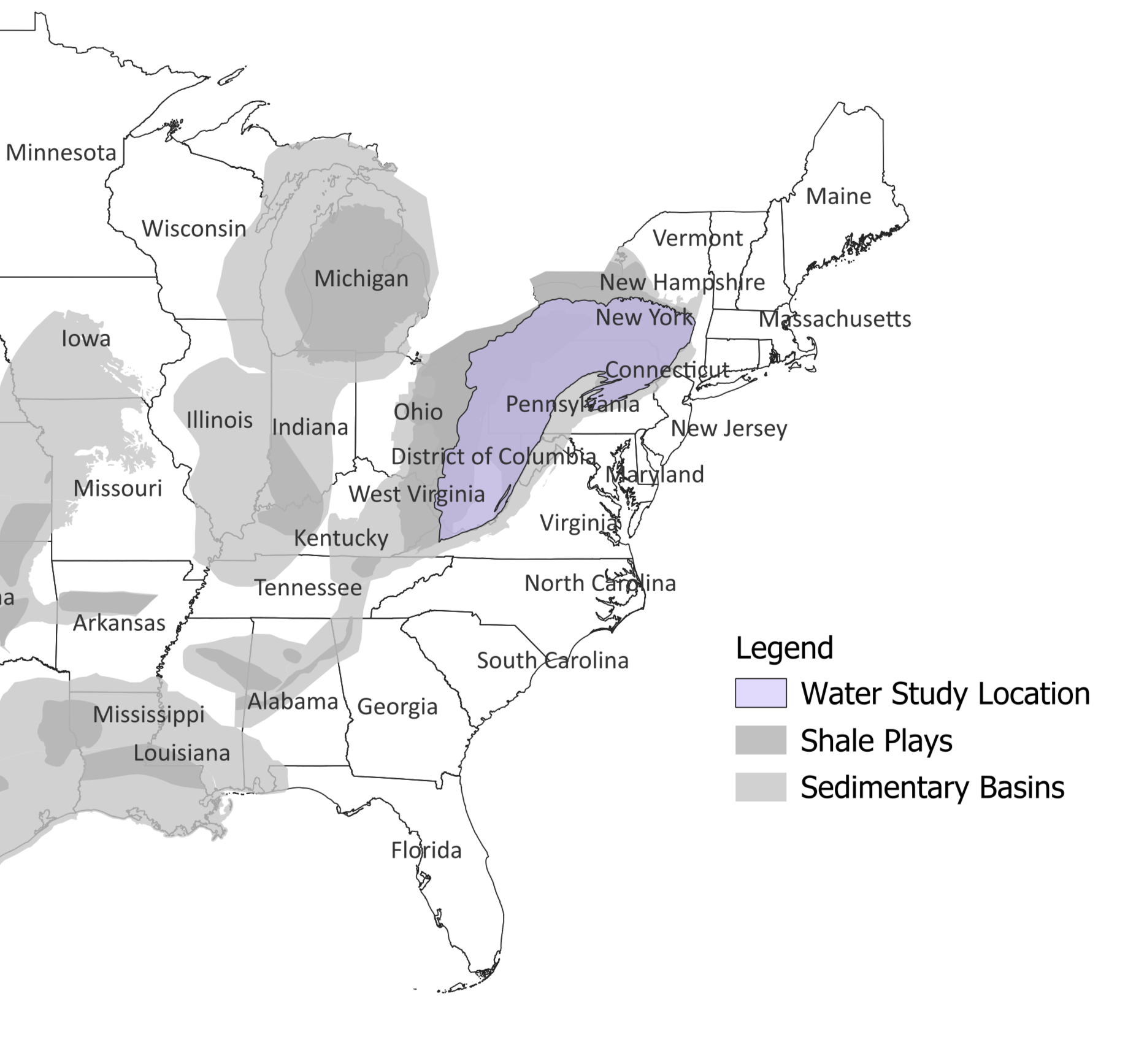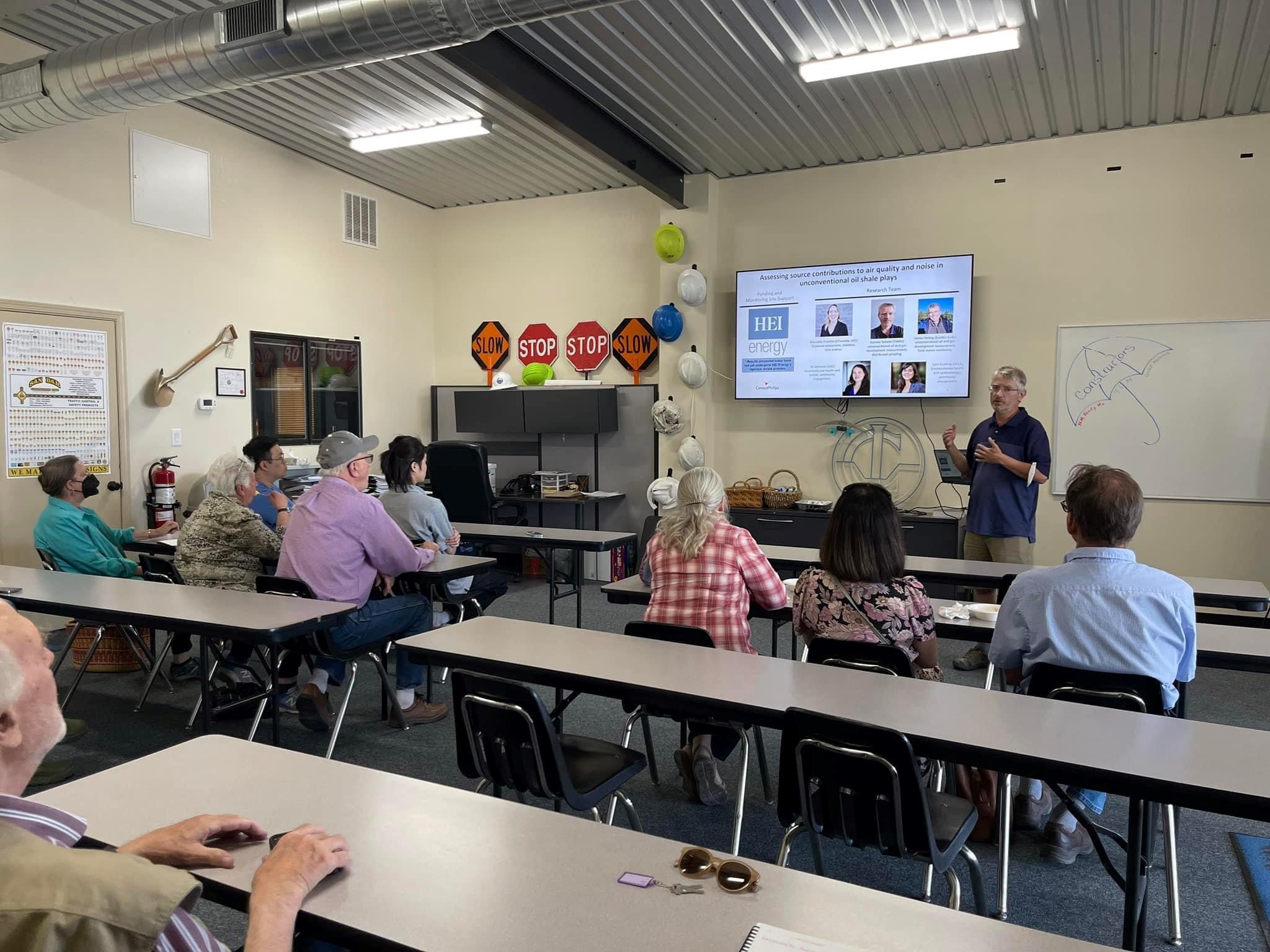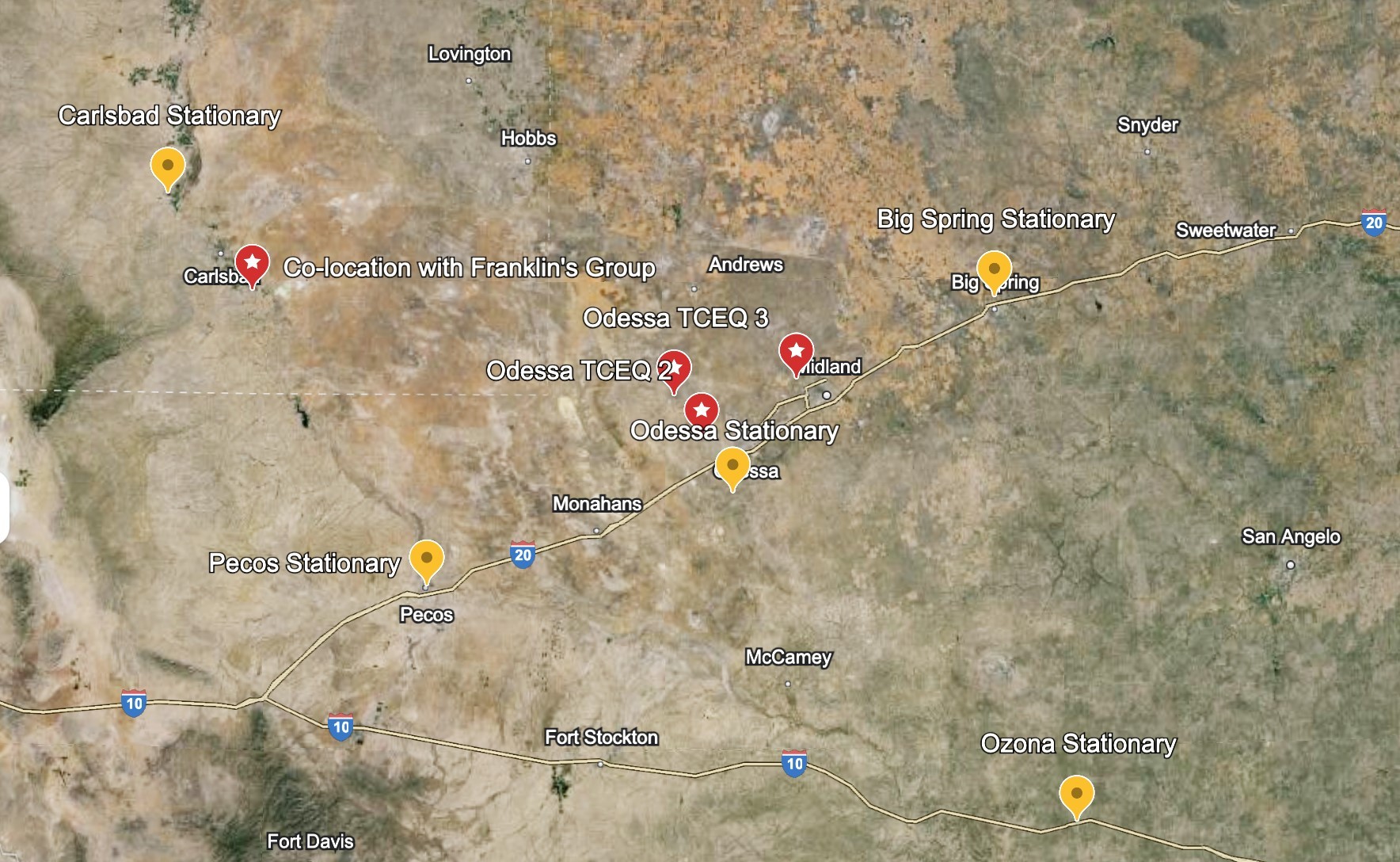Quarterly Update June 2024
HEI Energy's June 2024 Quarterly Research Updates are now available. You will find the latest progress from each of our 5 exposure studies in communities affected by oil and gas development.
Project Updates
Air Quality and Noise Research
Measuring and Modeling Air Pollution and Noise Exposure Near Unconventional Oil and Gas Development in Colorado
The goal of this study is to develop community exposure profiles in the Colorado North Front Range for chemicals in the air as well as noise over the UOGD lifecycle, from site preparation through production of multi-well pads. This study will assess potential exposure pathways connecting UOGD chemical emissions to nearby communities and use the results to better understand the public health implications. The investigators will apply the following methods to achieve these goals:
- Use a combination of existing air quality data, innovative air quality measurements, and source apportionment models to quantify potential exposures.
- Collect noise measurements from UOGD operations to quantify potential exposures.
- In collaboration with the Hildebrandt Ruiz team, develop the "TRAcking Community Exposures and Releases" (TRACER) model for use in the Denver-Julesburg region to predict chemical emissions from specific UOGD processes. The teams will combine the predicted emissions with an air quality model to estimate concentrations of chemicals in the air.
- Evaluate model performance by comparing air quality monitoring data collected by this and the Franklin team with model predictions in the Denver-Julesburg region.

What's Happened
- Reported that the use of closed-loop, tankless systems during flowback operations can greatly reduce average emissions of volatile organic compounds (VOCs).
- Observed short bursts of elevated VOC concentrations tied to the periodic emptying of sand traps, which capture fracturing sand that returned to the surface with flowback.
- Received permission to conduct air quality and noise monitoring during flowback operations at two UOGD well pads near Windsor, Colorado.
- Colorado State University (CSU) graduate student, Weixin Zhang, completed a draft master’s thesis on determining emission rates of specific VOCs during pre-production operations using measurements of ambient concentrations of VOCs from a recent study near UOGD operations in Broomfield, Colorado.
- Presented a scientific research poster at the HEI Annual Conference 2024 in Philadelphia, PA, April 28-30.
What's New
- Completing air quality and noise monitoring around hydraulic fracturing operations at two UOGD pads near Windsor, Colorado, and around production operations at a well pad near Aurora, Colorado.
- Simulating air dispersion around study well pads to facilitate a comparison between predicted and observed concentration distributions during specific UOGD operations.
- Examining and characterizing noise observations during drilling operations at a study pad near Brighton, Colorado, using information provided by drilling records.
What's Next
- Complete air quality and noise monitoring around two flowback operations during the spring and summer of 2024.
- Continue to develop the emissions model and simulate the dispersion of modeled emissions to compare with ambient air concentrations observed during well drilling and completion operations at four study pads near Aurora, Brighton, and Windsor, Colorado.
- Expand emission model user choices for operational practices and associated emission rates to provide greater utility for application to UOGD operations with practices that differ from those studied in the Denver-Julesburg Basin.
Assessing Source Contributions to Air Quality and Noise in Unconventional Oil Shale Plays
The goal of this study is to understand potential community exposure to UOGD-associated chemicals and radioactivity in air as well as noise. The investigators will apply the following methods to achieve their goals:
- Monitor air quality and noise in the Permian region of New Mexico and the Eagle Ford region of Texas to understand how potential exposures vary across the regions and over different time scales.
- Combine existing air monitoring data in the Denver-Julesburg region of Colorado and original data collected in the Permian and Eagle Ford regions with statistical models to distinguish UOGD from other sources of chemicals in the air and noise sources.
- Leverage satellite data to examine the association between natural gas flaring and air quality.
Collaborate with the Collett and Hildebrandt Ruiz teams to evaluate the "TRAcking Community Exposures and Releases" (TRACER) model performance in the Denver-Julesburg and Eagle Ford regions.

What's Happened
- Continued monitoring air quality from a stationary monitoring location in Loving, NM.
- Hosted a community meeting and informational session on May 8, 2024, in Carlsbad, New Mexico, to discuss study findings to date and tour the University of Texas’ (UT) mobile monitoring van (Figure 1).
- Conducted a mobile monitoring campaign in collaboration with Dr. Lea Hildebrandt Ruiz’s research team at UT and under Dr. Pawel Misztal’s (UT) leadership. An electric van was used to monitor five routes in Texas and New Mexico within the Permian Basin between late-April and mid-May. The van was parked for several days at the stationary monitoring location in Loving, NM, to compare findings from the mobile and stationary monitoring.
- Presented a scientific research poster at the HEI Annual Conference 2024 in Philadelphia, PA, April 28-30.
What's New
- Monitoring air quality and noise at the stationary monitoring location in Loving, NM, and conducting a passive air quality monitoring campaign in the Carlsbad-Loving area with the support of volunteers from the community.
- Analyzing data from the stationary and passive monitoring programs by linking the air samples with satellite data on flaring activity, well locations, and oil and gas production data.
- Continuing spatial and temporal trend analyses and source apportionment investigations.
What's Next
- Continue passive sampling until June/July 2024, completing a full season of measurements.
- Deploy passive samplers in the Eagle Ford Shale region beginning in June 2024.
- Host the next community outreach event in August 2024 (Date TBD).
Predictive, Source-oriented Modeling and Measurements to Evaluate Community Exposures to Air Pollutants and Noise from Unconventional Oil and Gas Development
The goal of this study is to develop a broadly applicable model, the "TRAcking Community Exposures and Releases" (TRACER) model. The model will assess potential community exposures to chemicals in the air from UOGD and inform future health studies. The model will then be used to predict the magnitude and frequency of emissions from individual UOGD sources, and when coupled with dispersion modeling, will generate concentrations of chemicals in the air. The investigators will apply the following methods to achieve their goals:
- Collect stationary and mobile air quality and noise measurements in the Eagle Ford, Texas region.
- In collaboration with the Collett team, develop the TRACER model in the Eagle Ford region to generate chemical emissions data from specific UOGD processes. The teams will combine the predicted emissions with air quality models to estimate local and regional concentrations of chemicals in the air.
- Expansion of the TRACER model to the Marcellus region, leveraging data from the separately funded Appalachian Methane Initiative.
- Evaluate model performance by comparing air quality monitoring data with model predictions in the Eagle Ford region.
- Use TRACER model results to assess spatial and temporal variability of potential community exposures to UOGD-associated chemicals and evaluate the effects of different UOGD sources on potential community exposures.

What's Happened
- Deployed a mobile monitoring platform to the Permian Basin (Figure 1).
- Conducted a mobile monitoring campaign in collaboration with Dr. Meredith Franklin’s research team and under Dr. Pawel Misztal’s (UT) leadership. An electric van was used to monitor five routes in Texas and New Mexico within the Permian Basin between late-April and mid-May. The van was parked for several days at the stationary monitoring location in Loving, NM, to compare findings from the mobile and stationary monitoring (Figure 2).
- Conducted a community outreach event in Loving, NM (Figure 3). · Presented four scientific research posters at the HEI Annual Conference 2024 in Philadelphia, PA, April 28-30.
What's New
- Analyzing and synthesizing all data from stationary and mobile monitoring in Texas and New Mexico.
- Evaluating plume imagery from aerial overflights in the Marcellus Shale region to identify emission events.
- Running a first iteration of coupled emissions and dispersion modeling to evaluate community exposures to emissions from UOGD in the Eagle Ford Shale.
- Preparing technical guidance documents for several emission sources, which will be made available with the final TRACER model.
What's Next
- Finalize data analysis and incorporate results from measurements into the TRACER model.
- Prepare updated estimates of community exposures to pollutants from UOGD.
Water Quality Research
Using Geoscientific Analysis and Community Engagement to Analyze Exposures to Potential Groundwater Contamination
The study is complete and now undergoing peer review and an independent quality assurance/quality control audit before HEI Energy releases the research report in the first part of 2026.
The overall goal of this study is to evaluate potential linkages between unconventional oil and gas development (UOGD) and groundwater contamination in a tri-county region of Pennsylvania with many overlapping potential sources of contamination. The analysis will be informed by focus groups in the region to help identify areas of community concern. The team plans to produce a broadly applicable framework to study the relationship between specific UOGD processes and potential groundwater contamination. The investigators will apply the following methods to achieve their goals:
- Combine an existing data set of chemical measurements in groundwater with machine learning to isolate the influences of natural and anthropogenic processes on groundwater chemistry and to identify chemical signatures of UOGD.
- Evaluate linkages between UOGD and potential water contamination.
- Develop an approach to map locations of potential contamination from UOGD activities for application to future investigations of potential human exposures and health effects associated with UOGD.
- Collected and analyzed well water samples well water in “hot spots” identified through their analysis as likely locations of wastewater spills, in order to evaluate the team’s approach.

What's Happened
- Conducted a reconnaissance trip to Southwest Pennsylvania in early May 2024 to prepare for water quality monitoring (Figures 1 and 2).
- Presented a scientific research poster at the HEI Annual Conference 2024 in Philadelphia, PA, April 28-30.
What's New
- Recruiting for the next phase of the study in Southwestern Pennsylvania, which will consist of monitoring water quality and surveying residents.
- Interested in participating? To learn more about this phase of the study and to sign up to have your water sampled, please visit the project website: https://sites.psu.edu/swpawaterproject/
What's Next
- Continue sampling trips to Southwestern Pennsylvania throughout the summer of 2024.
- Analyze water quality samples as they are collected.
Upcoming Events
- Mr. Shaheen will present a paper, partially based on this project, at the 2024 Goldschmidt Conference in Chicago, IL, August 18-23 titled "Understanding methane reactivity in the critical zone using abandoned oil and gas wells"
A Groundwater Modeling Framework for Elucidating Community Exposures Across the Marcellus Region to Contamination Associated with Oil and Gas Development
The study is complete and now undergoing peer review and an independent quality assurance/quality control audit before HEI Energy releases the research report in the first part of 2026.
The research team will build and test a model for understanding residential well water vulnerability to contamination from unconventional oil and gas development (UOGD) across the Marcellus region. This analysis will increase the understanding of risk to groundwater quality using publicly available data describing UOGD spills. The investigators will achieve their goal by:
- Modeling residential drinking water well vulnerability to contamination from UOGD sources over time across the Marcellus region. The model will describe how contaminants move in the subsurface.
- Using the model to understand the likelihood that specific UOGD spills will contaminate the water in residential wells.
- Refining the model and assessing its performance with statistical analyses using the characteristics of documented cases of UOGD spills and known contamination at well locations.

What's Happened
- Launched the study on April 1, 2024.
- Presented a scientific research poster at the HEI Annual Conference 2024 in Philadelphia, PA, April 28-30.
What's New
- Acquiring data on hydrogeologic conditions, drinking water quality, and UOGD well pad locations and spills in the Marcellus Shale region.
- Commence development of a regional-scale groundwater flow model to support estimates of drinking water vulnerability to UOGD contamination across the Marcellus Shale region.
What's Next
- Calibrate and test the regional-scale groundwater flow model with data on groundwater levels, land-surface expressions of the water table, and groundwater discharges to streams.
- Link calibrated groundwater flow model with particle-tracking model to simulate the transport of UOGD fluids away from well pads and analyze transport pathways to quantify vulnerability to drinking water sources.







